Projetos de Investigação
Factores decisivos para o sucesso da criação do CIAUD-UPT foram a atividade de investigação anteriormente desenvolvida no âmbito do CI-ESG e agora no CIAUD-UPT, que regularmente ganha financiamentos competitivos de programas de investigação Nacionais e Europeus, tais como FCT, Cultura 2000, Europa Criativa, InterReg, POCTEP, etc. A grande variedade de projectos foi possível devido ao elevado número de candidaturas anuais apresentadas, respondendo à crescente competitividade do grupo.

ArchiSpace
Acrónimo: ArchiSpace
Título do Projeto: ArchiSpace: Design e prototipagem de arquitetura espacial em ambientes análogos planetários
Programa de financiamento: HORIZON Europe | Marie Skłodowska-Curie Actions (MSCA)
Período: 2024-2028
Entidades:
- IRSPS SRL – International Research School of Planetary Sciences (Italy) (Project Leader)
- T.U. DELFT (The Netherlands)
- UPT – Universidade Portucalense, CIAUD-UPT (Portugal)
- UL – Université de Lyon 1 Claude Bernard (France)
- Vertico BV (The Netherlands)
- HUN-REN – Research Centre for Astronomy and Earth Sciences (Hungary)
- UPescara – Università degli Studi G. d’Annunzio Chieti – Pescara (Italy)
- UCA – Université de Cadi Ayyad (Morocco)
- UPC- Universidade Politécnica da Catalunha (Espanha)
Coordenação:
- Gian Gabriel Ori, IRSPS SRL (Project Leader & IRSPS SRL Coord.)
- Mariana Correia, CIAUD-UPT (UPT coord.)
Equipa de Investigação CIAUD-UPT:
- Telma Ribeiro, CIAUD-UPT (WP4.3-Coord.)
Susana Milão, CIAUD-UPT (WP4.1-Coord.)
Rui Florentino, CIAUD-UPT (WP4.1-Coord.)
Alexandra Araújo, CINTESIS.UPT (WP4.1-Coord.)
Sandra Fernandes, CINTESIS.UPT (WP4.1-Coord.)
Isabel Clara Neves, CIAUD-UPT (WP4.2-Coord.)
Ana Lima, CIAUD-UPT (WP4.2-Coord.)
Mónica Alcindor, CIAUD-UPT
Joaquim Flores, CIAUD-UPT
Emilia Simão, CIAUD-UPT
Bernardo Amaral, DAMG
Ivo Teixeira, DAMG
Alexandre Clément, DAMG
Pedro Rodrigues, CINTESIS.UPT
- Elsa Teixeira, CINTESIS.UPT
- Ana Bartolo, CINTESIS.UPT
Resultados Esperados:
32 deslocações; 4 relatórios; várias publicações.
Palavras-Chave: Arquitetura espacial, alterações climáticas, habitats resilientes, arquitetura em terra, impressão 3D.
Resumo:
Nesta década, pretendemos regressar à Lua para ficar. Por isso, é crucial desenvolver assentamentos fiáveis e seguros que protejam adequadamente o bem-estar humano das possíveis ameaças que o ambiente hostil apresenta. O ArchiSpace tem como objetivo projetar e construir protótipos de subsistemas (tais como espaços habitacionais) de infraestruturas humanas a serem construídas em superfícies planetárias, que serão testados em ambientes planetários análogos. O ArchiSpace é pioneiro num novo campo de investigação interdisciplinar e intersetorial na Europa, fazendo a ponte entre as ciências geológicas/espaciais e a arquitetura/arquitetura espacial. Em particular, os habitats «centrados no ser humano» têm um papel fundamental na conceção de habitats confortáveis, seguros e funcionais. Isto será possível através do estudo da arquitetura adaptativa e resiliente face às alterações climáticas, mas também da qualidade dos espaços no património vivo, como a arquitetura vernacular, adaptada a ambientes extremos.

Resilient Mozambique
Acrónimo: Resilient Mozambique
Título do projeto: Participação da comunidade na avaliação do estado de conservação do património e dos mecanismos de resiliência em resposta aos riscos e catástrofes provocados pelo ciclone Gombe.
Entidade de Financiamento: GACIM, Ministério de Cultura de Moçambique, financiado pelo Centro do Património Mundial da UNESCO– Paris (Contrato no 4500517809)
Referência do projeto:
Contrato nº 4500517809 / Assistência Internacional ao Património Mundial – resposta nº 3428
Organização: GACIM – Gabinete de Conservação da Ilha de Moçambique
Entidades: CIAUD-UPT & GACIM
Periodo: 2025
Coordenação: Mariana Correia, CIAUD-UPT (Project Leader & WP1-Coord.)
quipa de investigação CIAUD-UPT:
- Telma Ribeiro, CIAUD-UPT (WP2-Coord.)
- Joaquim Flores, CIAUD-UPT (WP3-Coord.)
- Susana Milão, CIAUD-UPT (WP4-Coord.)
- Isabel Clara Neves, CIAUD-UPT.
- David Viana, CIAUD-UPT.
Estudante de doutoramento CIAUD: Olga Alvarez, CIAUD.
Estudante de Mestrado UPT: Cristina Azevedo, DAMG
Resultados: Foram apresentados quatro resultados: 1) Cursos de capacitação em: Património Mundial, Diagnóstico e Conservação, Ferramentas de Gestão e Habitat Resiliente; 2) Estado de conservação da ilha após o ciclone através de um levantamento de conservação de 100 edifícios; 3) Desenvolvimento de uma ferramenta de gestão multissetorial para responder a desastres por meio do mapeamento da ilha usando SIG-Sistemas de Informação Geográfica e mapeamento colaborativo de fatores de risco associados a fenómenos climáticos; 4) Folheto com recomendações para um habitat mais resiliente diante de ciclones. Essa abordagem integrada permitiu obter uma atualização do estado atual do património, um mapa das áreas mais vulneráveis, uma ferramenta de gestão abrangente e propostas de estratégias técnicas para a melhoria do habitat.
Palavras-chave: Alterações climáticas, ciclones, património mundial, SIG, conservação, habitat resiliente, Moçambique.
Resumo:
De acordo com o Índice Global de Risco Climático de 2021, Moçambique foi o país mais afetado pelas alterações climáticas em África. O impacto das alterações climáticas deverá aumentar nas próximas décadas. A Ilha de Moçambique, classificada como Património Mundial pela UNESCO desde 1991, enfrenta uma série de desafios relacionados com a sua preservação e vulnerabilidade a fenómenos meteorológicos extremos, especialmente ciclones.
A passagem do ciclone Gombe, em março de 2022, destacou a necessidade urgente de desenvolver estratégias de resiliência para proteger as comunidades locais e o património arquitetónico dos impactos destas catástrofes naturais. A Ilha, com a sua história e cultura, possui um legado material e imaterial que precisa de ser protegido e gerido de forma sustentável, face às crescentes ameaças climáticas. Este projeto foi fundamental para garantir que a Ilha de Moçambique pudesse tornar-se um exemplo de boas práticas em matéria de conservação e prevenção, face aos desafios colocados pelas alterações climáticas. Através da criação de instrumentos de gestão resilientes e do reforço das capacidades locais, o projeto contribuiu para reforçar a proteção da Ilha de Moçambique e da sua população, face às catástrofes naturais.

MetroPoLis
Acrónimo: MetroPolis
Título do Projeto: MetroPoLis. Lisboa e Porto como metrópole partilhada. Turismo sustentável para além do centro urbano
Programa: Projeto embrionário CIAUD. Financiado pela FCT – Fundação para a Ciência e a Tecnologia, I.P., no âmbito do Projeto Estratégico com as referências UIDB/04008/2020 e UIDP/04008/2020.
Período: 2024-25
Entidades:
- Área Metropolitana de Lisboa (AML)
- Câmara Municipal do Porto (CMP)
Coordenação CIAUD-UPT: Rui Florentino CIAUD-UPT
Equipa de Investigação CIAUD-UPT:
- Telma Ribeiro, CIAUD-UPT
- Mónica Alcindor, CIAUD-UPT
Colaboradores CIAUD-UPT:
- David Viana, CIAUD-UPT
- Isabel Vaz Freitas, CIAUD-UPT
- Goreti Sousa, CIAUD-UPT
Colaboradores Externos:
- Patricia Canelas, Oxford University
- Jorge Ricardo Pinto, ISCET, Porto
- José Pedro Tenreiro
Resultados: Seminários, Atas de Conferência, Artigos Científicos.
Website: https://metropolisplatform.com/
Palavras-chave: Lisboa, Área Metropolitana do Porto, Turismo Sustentável.
Resumo:
As áreas metropolitanas podem ser, atualmente, os atores mais relevantes em termos de liderança e competitividade. Moldam o nosso atual “modo de vida” e exigem um nível mais elevado de coordenação no planeamento regional e na governação institucional. O turismo internacional emergiu como um elemento económico fundamental para a governação metropolitana e, possivelmente, terá ainda maior relevância nos próximos anos. Para o melhorar, investigação prévia demonstrou que as mudanças nos referenciais institucionais devem ser equilibradas com bons resultados decorrentes das componentes técnicas das práticas de planeamento. No contexto do objetivo de desenvolvimento sustentável para cidades e comunidades (ODS n.º 11), caso exista oportunidade de crescimento, talvez devamos distribuí-lo pelas áreas metropolitanas, para além dos centros urbanos. A análise irá abordar a questão central: como equilibrar as atividades turísticas com a coesão urbana de Porto e Lisboa?

Ressonâncias
Acrónimo: Ressonâncias
Programa de Financiamento: Gulbenkian — Programa PARTIS & Art for Change
Organizaçãor: Rio Neiva – Environmental NGO (Coord.)
Período: 2027
Entidades:
- NICE – Núcleo de Intervenção Cultural de Esposende (Parceiro)
- Escola Henrique Medina (Parceiro)
- Câmara Municipal de Esposende (Parceiro)
- Universidade Portucalense, CIAUD-UPT (Parceiro)
Coordenação: Clara Roberti, CIAUD-UPT
Equipa de investigação CIAUD-UPT: Ana Clara Roberti, CIAUD-UPT, Emilia Simão, CIAUD-UPT, Damião Matos, CIAUD-UPT
Resultados esperados: Teaser do projeto em vídeo, performance-instalação, exposição fotográfica, manual de reflexão e avaliação, documentário etnográfico (em andamento).
Website: https://rioneiva.com/ressonancias/
Resumo:
Com base no Diagnóstico Social de Esposende (2023) e nas necessidades sociais e educativas específicas identificadas, o projeto «Resonâncias» visa estruturar e melhorar o processo de acolhimento e integração social dos jovens migrantes de Esposende num contexto escolar através de práticas artísticas sonoras, tendo a água como enquadramento e elemento orientador, promovendo afetos interculturais, a partilha de experiências e uma ampla participação na comunidade.

SizaATLAS
Acrónimo: SizaAtlas
Título do Projeto: SIZATLAS: Colmatar lacunas para o Património
Programa de Financiamento: FCT – Fundação para a Ciência e a Tecnologia | Programa Siza
Referência do Projeto: SIZA/ETM/0023/2019
Entidades:
- ISCTE/ISTAR-IUL – Instituto Universitário de Lisboa / Centro de Investigação em Ciências da Informação, Tecnologias e Arquitetura.
- FAUP/CEAU – Faculdade de Arquitetura da Universidade do Porto / Centro de Estudos de Arquitetura e Urbanismo.
- UPT/CIAUD-UPT – Universidade Portucalense / Centro de Investigação em Arquitetura, Urbanismo e Design – polo da Universidade Portucalense.
Coordenação:
- Soraya Genin IRSPS SRL (Project Leader & ISCTE Coord.)
- Teresa Ferreira (FAUP coord.)
- Mariana Correia, CIAUD-UPT (UPT coord.)
Equipa de Investigação CIAUD-UPT:
- Mariana Correia (coord.), CIAUD-UPT
- Telma Ribeiro, CIAUD-UPT
- Gilberto Carlos, CIAUD-UPT
- Ana Lima, CIAUD-UPT
- Goreti Sousa, CIAUD-UPT
- Rui Florentino, CIAUD-UPT
Colaboradores CIAUD-UPT:
- Susana Milão, CIAUD-UPT
- Joaquim Flores, CIAUD-UPT
- Isabel Clara Neves, CIAUD-UPT
- Joana Vieira da Silva, DAMG
- Paulo Guerreiro, DAMG
- Bruno de Andrade, DAMG
Investigador FCT UPT: Uriel Perles
Resultados: Plataforma com o inventário de todas as obras de Siza; mapa com a localização de todas as obras de Siza; publicações (um livro geral e 18 booklets).
Website: https://sizaatlas.iscte-iul.pt/
Keywords: SizaAtlas, Património Mundial, Atlas, Alterações Climáticas (relação com a água)
Resumo:
O projeto SizaATLAS tem como objetivo realizar um inventário abrangente de todas as obras construídas de Álvaro Siza e desenvolver documentação e análise detalhada dos 18 edifícios selecionados para integração na Lista do Património Mundial. Esta investigação, associada à comparação com outras arquiteturas contemporâneas, permitirá aprofundar o entendimento do valor único da arquitetura de Siza, no contexto nacional e internacional. Tal será fundamental para estabelecer a justificação do Valor Universal Excecional (VUE) da sua obra, garantir a sua proteção nacional e definir um sistema de gestão eficaz que sustente a candidatura das obras de Siza à Lista do Património Mundial.
A equipa de investigação possui competências multidisciplinares nas áreas da Arquitetura, História, Património Mundial, Tecnologia, Engenharia e Tecnologias da Informação, reunindo as capacidades necessárias para desenvolver as várias tarefas previstas. Inclui ainda especialistas nacionais e internacionais com reconhecido percurso, conhecimento aprofundado da obra de Siza e experiência em Património Mundial. Numa estratégia participativa, o inventário contará com a colaboração de organizações nacionais e internacionais.

VERSUS+
Acrónimo: VERSUS+
Título do Projeto: VerSus+: Património para as pessoas.
Entidades:
- UPV – Universidade Politécnica de Valência (Espanha) (Project Leader)
- CIAUD-UPT – Polo da Universidade Portucalense do Centro de Investigação em Arquitetura, Urbanismo e Design
- UNIFI – Universidade de Florença (Itália)
- UNICA – Universidade de Cagliari (Itália)
- CRATerre – Escola de Arquitetura de Grenoble (França)
Coordenação:
- Camilla Mileto & Fernando Vegas UPV (Project Leader & Coord. UPV )
- Mariana Correia, CIAUD-UPT (UPT coord.)
Investigadores CIAUD-UPT:
- Gilberto Carlos, CIAUD-UPT
- Ana Lima, CIAUD-UPT
- Monica Alcindor, CIAUD-UPT
- Emilia Simão, CIAUD-UPT
- Goreti Sousa, CIAUD-UPT
- Rui Florentino, CIAUD-UPT
- Telma Ribeiro, CIAUD-UPT
- Isabel Freitas, REMIT
- Teresa Correia, UPT
Resultados: Livro, Atas de Conferência, booklet, App, Jogos, Festivais, Exposições, Atividades.
Website: https://versus-people.webs.upv.es/
Palavras-chave: Património vernacular, artesãos, arquitetura sustentável
Resumo:
Como continuação do projeto VerSus, o projeto VERSUS+ centra-se na transmissão do conhecimento do património vernacular a diferentes setores da sociedade e ao público em geral. Dá especial atenção à sociedade do futuro (crianças e jovens), bem como às autoridades locais, regionais e nacionais responsáveis pela gestão do património, incluindo especialistas na área da arquitetura, juntamente com artesãos, empresas dos setores da construção e do turismo, associações culturais e sociais e instituições de ensino. Acima de tudo, desempenha um papel essencial na sociedade contemporânea, ao evidenciar princípios e ensinamentos relevantes para uma arquitetura sustentável e respeitadora.

3DPAST
Título do Projeto: 3DPAST: Património Mundial Europeu vivido & visitado virtualmente.
Referência do Projeto: 607593-CREA-1-2019-1-ES-CULT-COOP1
Período: 2016-2020
Entidades:
- ESG – Escola Superior Gallaecia / atualmente integrada na UPT e no CIAUD-UPT – polo da Universidade Portucalense do Centro de Investigação em Arquitetura, Urbanismo e Design (Portugal) (Project Leader)
- UPV – Universidade Politécnica de Valência (Espanha)
- UNIFI – Universidade de Florença (Itália)
Coordenação: Mariana Correia, CIAUD-UPT (Project Leader & Coord. UPT)
Investigadores CIAUD-UPT:
- Gilberto Duarte Carlos, CIAUD-UPT
- Ana Lima, CIAUD-UPT
- Mónica Alcindor, CIAUD-UPT
- Emilia Simão, CIAUD-UPT
- Goreti Sousa, CIAUD-UPT
- Rui Florentino, CIAUD-UPT
- Damião Matos, DAMG
- Luis Paulo Pacheco, DAMG
- Teresa Correia, UPT
Resultados: 8 missões a sítios de Património Mundial na Albânia, Geórgia, Finlândia, Roménia, Grécia, Itália, Espanha e Portugal (Açores); plataforma 3DPAST; Livro 3DPAST: From Vernacular to World Heritage (2020); App 3DPAST; booklet 3DPAST; Conferência Internacional Heritage 2020; Atas Heritage 2020; Serious Games; Exposições; Vídeos; 8 workshops científicos em universidades europeias.
https://esg.pt/3dpast/platform/
Palavras-chave: Património Mundial, arquitetura vernacular, património vivo, 3D, VR, AR, arte na arquitetura

Seismic-V
Acrónimo: SEISMIC-V
Título do Projeto: SEISMIC-V: Cultura Sísmica Local em Portugal.
Programa de Financiamento: FCT – Fundação para a Ciência e a Tecnologia
Referência do Projeto: PTDC / ATP-AQI / 3934/2012
Entidades:
- ESG – Escola Superior Gallaecia / atualmente integrada na UPT e no CIAUD-UPT – polo da Universidade Portucalense do Centro de Investigação em Arquitetura, Urbanismo e Design (Portugal) (Project Leader)
- UM – Universidade do Minho (Portugal)
- UA – Universidade de Aveiro (Portugal)
Coordenação: Mariana Correia, ESG/CIAUD-UPT (Project Leader)
Investigadores CIAUD-UPT:
- Gilberto Duarte Carlos, CIAUD-UPT
- David Viana, CIAUD-UPT
- Goreti Sousa, CIAUD-UPT
- Ana Lima, CIAUD-UPT
- Teresa Correia, UPT
Resultados:
Duas publicações: Local Seismic Culture in Portugal & Seismic Retrofitting: Learning from Vernacular Architecture; Conferência Internacional CIAV 2013; Atas da Conferência: Vernacular Heritage & Earthen Architecture: Contributions for Sustainable Development (2013).
https://esg.pt/ciav2013/
Palavras-chave: Património Mundial, arquitetura vernacular, património vivo, 3D, VR & AR, arte na arquitetura.

TEMPUS 3D
Acrónimo: TEMPUS 3D
Título do Projeto: Tempus 3D – Design para o Desenvolvimento Sustentável das Produções Artesanais Locais.
Programa de Financiamento: TEMPUS
Referência do Projeto: 544106-TEMPUS-1-2013-1-IT-TEMPUS-JPCR
Período: 2013-2017
Coordenação:
- Saverio Mecca, UNIFI (Project Leader)
- Mariana Correia, CIAUD-UPT (Coord. ESG/UPT)
Investigadores CIAUD-UPT:
- Emilia Simão, CIAUD-UPT
- Gilberto Duarte Carlos, CIAUD-UPT
- David Viana, CIAUD-UPT
- Goreti Sousa, CIAUD-UPT
- Teresa Correia, UPT
- UNIFI – Universidade de Florença (Itália) (Project Leader)
- ESG – Escola Superior Gallaecia /atualmente integrada na UPT e no CIAUD-UPT – polo da Universidade Portucalense do Centro de Investigação em Arquitetura, Urbanismo e Design (Portugal)
- POLITO – Politécnico de Turim (Itália)
- UB – Universidade de Barcelona (Espanha)
- CSM – Centro Experimental do Mobiliário (Itália)
- ESSTED – École Supérieure des Sciences et Technologies du Design de Tunis (Tunisia)
- ISBAS – Institute Supérieur de Beaux-Arts de Sousse (Tunisia)
- ISAM-K – Institute Supérieur des Arts et Métiers de Kasserine (Tunisia)
Resultados: 1 livro e vários cursos de capacitação na Tunísia, Portugal e Itália
Palavras-chave: Mestrados em Design, Tunísia, desenvolvimento sustentável, produção artesanal local
Website: https://www.esg.pt/ciesg/tempus-3d/
Resumo:
O Programa Europeu Tempus (ERASMUS+) tinha como objetivo promover a modernização e o desenvolvimento de competências no ensino superior em países parceiros da UE. O projeto TEMPUS 3D procurou desenvolver formação de 2.º ciclo (Mestrado) em áreas prioritárias na Tunísia: Ciências Humanas e Artes, no domínio do Design. O mestrado concentrou-se no design orientado para o desenvolvimento sustentável da produção artesanal local. O projeto formou designers nas três universidades parceiras tunisinas, trabalhando em estreita colaboração com artesãos locais para o desenvolvimento do sistema produtivo, com vista à inovação ao nível do design, da produção e do mercado.

VerSus
Título do Projeto: VerSus: Lições do Património Vernacular para uma Arquitetura Sustentável.
Período: 2012-2014
Coordenação: Mariana Correia, CIAUD-UPT (Project Leader & diretora.)
Investigadores CIAUD-UPT:
- Gilberto Carlos, CIAUD-UPT (Coord.)
- Ana Lima, CIAUD-UPT
- Mónica Alcindor, CIAUD-UPT
- Goreti Sousa, CIAUD-UPT
- David Viana, CIAUD-UPT.
- Teresa Correia, UPT
Entidades:
- ESG – Escola Superior Gallaecia / atualmente integrada na UPT e no CIAUD-UPT – polo da Universidade Portucalense do Centro de Investigação em Arquitetura, Urbanismo e Design (Portugal) (Project Leader)
- UPV – Universidade Politécnica de Valência (Espanha) (Spain)
- UNIFI –Universidade de Florença (Itália)
- UNICA – Universidade de Cagliari (Itália)
- CRATerre – Escola de Arquitetura de Grenoble (França)
Resultados: Livro: VERSUS Heritage for Tomorrow; booklet VERSUS; Conferência Internacional CIAV2013; Conferência Internacional VERSUS 2014; 3 Atas de Conferência: Vernacular Heritage & Earthen Architecture: Contributions for Sustainable Development (2013); Vernacular Architecture: Towards a Sustainable Future (2014); Earthen Architecture: Past, Present and Future (2014).
Resumo:
O objetivo principal do projeto foi adquirir conhecimento a partir das lições e princípios fundamentais da arquitetura vernacular e explorar novas formas de aplicar esses princípios na arquitetura sustentável contemporânea. O projeto de investigação VerSus baseou-se na identificação de estratégias e princípios presentes no património vernacular, com vista à definição de uma abordagem conceptual para o desenho arquitetónico sustentável.

Terra (In)cógnita II
Program: Culture 2000, European Commission
Period: 2009-2011
Partners:
- School of Avignon (France) (Project Leader).
- ESG – Escola Superior Gallaecia / now integrated at CIAUD-UPT (Portugal).
- UNIFI – University of Florence (Italy).
- UPV – Polytechnic University of Valencia (Spain).
- CAUE (France).
This is a follow up project of the TERRA INCÓGNITA one. It was based on scientific missions to the 27 countries of the European Union. It consists of defining the state of the art of European earth architecture, in terms of heritage and contemporary architecture; restoration and training; education and academic research; professionals and producers, etc. The intention is to produce a rigorous cartography of earth architecture in the 27 countries analyzed, as well as the recognition of key specialists, allowing the creation, consolidation and dissemination of an operative network of European specialists.

Cadivafor
Program: InterReg IIIA
Period: 2006-2008
Partners:
- CIEFAL-ICOMOS (Galicia-Spain) (Project Leader).
- ESG – Escola Superior Gallaecia / now integrated at CIAUD-UPT – Portucalense University’s pole of the Research Centre for Architecture, Urbanism and Design (Portugal).
- CIS Calicia – Tecnologia y Diseño (Galiciaa-Spain)
The project focuses on the transmission of knowledge of verncular heritage to all branches of society and the general public. It pays special attention to the society of the future (children and young people) as well as local, regional and national authorities in charge of heritage management including specialists in the field of architecture together with craftsmen and companies in the construction and tourism sectors, cultural and social associations and educational institutions. Above all it plays an essential role in contemporary society as it is able to teach us important principles and lessons for a respectful sustainable architecture.

CATPAP
Program: POS_C Vale do Minho Digital
Period: 2006-2008
Partners:
- ESG – Escola Superior Gallaecia / now integrated at CIAUD-UPT Portucalense University’s pole of the Research Centre for Architecture, Urbanism and Design (Portugal) (Project Leader).
- CIM-Alto Minho – Intermunicipal Community of Minho Valley
Completed in March 2008, the project consisted of the preparation of an integrated study of the architectural, archaeological and landscape heritage of the Minho Valley. The existing assets were cataloged through the creation of a database, elaborated in the “In Domus” program, structured in four generic themes: Military Architecture, Religious Architecture, Vernacular Architecture and Archaeological Heritage.

Terra Incógnita
Program: Culture 2000, European Commission
Period: 2006-2008
Partners:
- School of Avignon (France); CRATerre – Grenoble School of Architecture (France) (Project Leader).
- UNIFI – University of Florence (Italy).
- UPV – Polytechnic University of Valencia (Spain).
- ESG – Escola Superior Gallaecia / now integrated at CIAUD-UPT – Portucalense University’s pole of the Research Centre for Architecture, Urbanism and Design (Portugal).
The project was developed through the elaboration of the State of the Art, of earth architecture in Italy, France, Spain and Portugal, with regard to their heritage, contemporaneity, education, training and research. Publication of two European reference works on the subject: “Terra Incognita – Discover” (white book) and “Terra Incognita – Preserve” (manual).

Houses and Cities Built With Earth
Program: Culture 2000, European Commission
Period: 2005-2006
Partners:
- UNICA – University of Cagliari (Italy) (Project Leader).
- ESG – Escola Superior Gallaecia / now integrated at CIAUD-UPT – Portucalense University’s pole of the Research Centre for Architecture, Urbanism and Design (Portugal).
- UV – University of Valencia, History Department (Spain)
The project had as its fundamental objective the training of local technicians in the conservation of built heritage in earth architecture; holding intensive courses in Italy, Spain, Portugal and Morocco (Marrakech and Figuig) with the participation of specialists. Part of the results was formalized in a publication entitled “Houses and Cities Built With Earth: conservation, significance and urban quality”.
Conclusão
- As project leader, CIAUD-UPT (previously Ci-ESG) successfully concluded the following scientific projects:
- One project from Creative Europe: 3DPast – Living & virtual visiting European World Heritage (https://esg.pt/3dpast/) (2016-2020);
- One project from the Foundation for Science and Technology (FCT): SEISMIC-V – Vernacular Seismic Culture in Portugal (www.esg.pt/seismic-v) (2013-2015);
- One project from the European Culture 2000 program: VERSUS – Lessons from Vernacular Heritage to Sustainable Architecture (www.esg.pt/versus) (2012-2014);
- Two projects from POS_C Vale do Minho Digital program: CATPAP – Catalogue of the architectural and archaeological heritage of the Alto Minho region (www.esgallaecia.inwebonline.net) (2004-2008); Online Digital library (2004-2008).
- As partner, CIAUD-UPT (previously Ci-ESG) actively participated/participates in:
- One project from HORIZON program: Space Architecture design and prototyping in planetary analogue environments (2024-2028);
- One project from the Foundation for Science and Technology (FCT): SizaATLAS – Filling the Gaps of World Heritage (2021-2024);
- One project from Creative Europe: VERSUS+ | Heritage for People (2019-2023);
- One project from TEMPUS program: Tempus 3D – Design for the sustainable development of local handicraft production (2013-2017);
- Three projects from European Cultura 2000 program: Terra (In)cognita II/Terra Europae (2009-2011) ; Terra Incognita I (2006-2008); Houses and Cities built with Earth (2005-2006)
- One project from InterReg III program: CADIVAFOR – To catalogue, study and valuing the defensive fortresses of Galicia and the north of Portugal border (2006-2008);
- One project from Gulbenkian Programa PARTIS & Art for Change: Ressonâncias: fluxos sonoros e culturais a partir da água para a integração de estudantes migrantes (2025).
